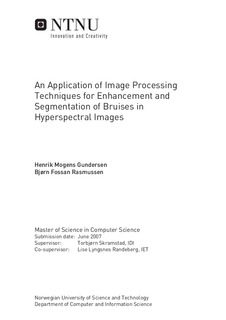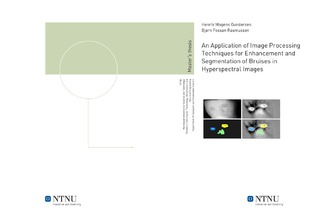| dc.description.abstract | Hyperspectral images contain vast amounts of data which can provide crucial information to applications within a variety of scientific fields. Increasingly powerful computer hardware has made it possible to efficiently treat and process hyperspectral images. This thesis is interdisciplinary and focuses on applying known image processing algorithms to a new problem domain, involving bruises on human skin in hyperspectral images. Currently, no research regarding image detection of bruises on human skin have been uncovered. However, several articles have been written on hyperspectral bruise detection on fruits and vegetables. Ratio, difference and principal component analysis (PCA) were commonly applied enhancement algorithms within this field. The three algorithms, in addition to K-means clustering and the watershed segmentation algorithm, have been implemented and tested through a batch application developed in C# and MATLAB. The thesis seeks to determine if the enhancement algorithms can be applied to improve bruise visibility in hyperspectral images for visual inspection. In addition, it also seeks to answer if the enhancements provide a better segmentation basis. Known spectral characteristics form the experimentation basis in addition to identification through visual inspection. To this end, a series of experiments were conducted. The tested algorithms provided a better description of the bruises, the extent of the bruising, and the severity of damage. However, the algorithms tested are not considered robust for consistency of results. It is therefore recommended that the image acquisition setup is standardised for all future hyperspectral images. A larger, more varied data set would increase the statistical power of the results, and improve test conclusion validity. Results indicate that the ratio, difference, and principal component analysis (PCA) algorithms can enhance bruise visibility for visual analysis. However, images that contained weakly visible bruises did not show significant improvements in bruise visibility. Non-visible bruises were not made visible using the enhancement algorithms. Results from the enhancement algorithms were segmented and compared to segmentations of the original reflectance images. The enhancement algorithms provided results that gave more accurate bruise regions using K-means clustering and the watershed segmentation. Both segmentation algorithms gave the overall best results using principal components as input. Watershed provided less accurate segmentations of the input from the difference and ratio algorithms. | nb_NO |

